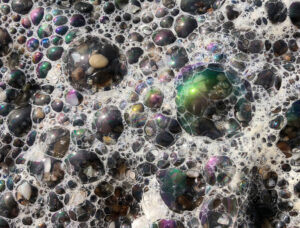Introduction
The first plastic polymer was invented in the 19th century, but it was not until after World War II that plastics were used to make huge numbers of inexpensive consumer products. Since then, plastic production has increased exponentially, as has the amount of plastic pollution in the ocean.
Plastic is lightweight and many plastic items are formed in shapes that make it easy to roll, fly, and float into the ocean. Better plastic recycling/remanufacturing laws and practices are part of the solution to this problem, but there are important actions we can take in our personal lives to prevent plastic from getting into the ocean. Focus on the more sustainable goal of reducing your use of plastic–this will go a long way toward reducing the amount of plastic in the environment.
Learn more about plastic in the ocean and ways you can help keep it out when you go shopping, at home, in the office, and in your community.
Start by measuring your “plastic footprint”: Keep a personal plastic use diary and note every product you use in a day or a week that’s packaged in plastic. Then you can begin to figure out how to reduce the amount of plastic packaging you buy or use. Every step you take personally helps prevent plastic from inadvertently ending up in the ocean.
Learn More About Plastic Pollution in the Ocean
Oikonos Winged Ambassadors Ocean Education Program
Information and free materials for teaching about ocean plastic pollution in the classroom and in the community.
Algalita Marine Research Foundation
Nonprofit organization dedicated to preservation of the marine environment through innovative research, education, and restoration. Current projects include pelagic plastic pollution research, watershed clean-up, kelp forest restoration, and classroom education for school groups.
Save the Bay: The Bay vs. The Bag
Campaign to keep plastic bags out of the ocean through citizen action and support for plastic bag ban legislation.
A Day without Plastic
Blog sponsored by nonprofit Ocean Revolution to share information about plastic in the ocean.
Ecology Center Plastics Task Force
Task force convened by Berkeley’s Ecology Center to study plastic waste issues as well as reduction and recycling programs, and to educate the public about plastic in the waste stream.
Kure Atoll Conservancy
Nonprofit organization dedicated to restoration of native habitat and protection of endangered species on Kure Atoll.
Keep Oceans Clean: Oceans Awareness Campaign
Educational website created by nonprofit-government agency collaboration. Includes an online marine debris game for children and adults as well as information on how each of us can help keep our oceans clean, links to other ocean awareness games online, and links to ocean resources for parents and teachers.
Help Keep Plastic Out of the Ocean
Participate in California Coast and Waterway Cleanups
California Coastal Cleanup Day
Annual state-wide volunteer beach trash clean-up event on the third Saturday in September.
Adopt-a-Beach Program
California Coastal Commission’s program for groups to help with beach clean-up year-round.
NOAA’s Marine Debris Educational Resources
Information about marine debris programs throughout the U.S., including many focused on California and the Pacific Ocean.
Information About Buying and Using Less Plastic
The Watershed Project: Reduce Your Plastic Footprint
Ten easy things you can do to reduce the amount of plastic that gets into waterways and the ocean.
Rise Above Plastic
Surfrider Foundation-sponsored program and website that provides information and suggestions for reducing your plastic footprint (including a soon-to-be-launched “plastic calculator”) and keeping plastic out of the ocean.
The Story of Stuff
A lively and informative 20-minute downloadable video that looks at the underside of our production and consumption patterns.
Fake Plastic Fish: Living Life with Less Plastic
One woman’s blog about her efforts to use less plastic. Includes many suggestions for alternatives to plastic in everyday life.
Green 11 Store
San Francisco store selling bulk organic beauty products and non-toxic cleaning supplies to fill customer’s own containers. 2164 Union Street, San Francisco
What You Can Do
When Shopping
Bring your own:
- durable reusable bags, baskets, and containers for shopping at all stores
- reusable lightweight cloth bags for produce
- mug or cup for take-out coffee, tea, smoothies, etc.
- reusable storage containers from home for restaurant meal leftovers
- food from home in place of buying takeout
Avoid plastic packaging.
Avoid buying bottled water; the caps are not recyclable and their size and shape increase the likelihood they will end up in the ocean.
Buy products with minimal or truly recyclable packaging:
- beverages and foods in glass containers with metal lids (and reuse the glass containers)
- berries in paper pulp baskets
- meat from the butcher counter and cheese from the deli counter–and ask that they be wrapped in butcher paper or waxed paper
- cream cheese packaged in foil rather than plastic tubs
- margarine in paper-wrapped cubes rather than plastic tubs
- powdered laundry detergent in paper boxes rather than liquid in plastic bottles (but watch out for plastic bags inside the boxes)
- toilet paper packaged in paper
- bar soap instead of liquid soap in plastic bottles
- wine in glass bottles with natural cork rather than plastic stoppers
- pet food and cat litter in paper bags or boxes
- nursery plants in pressed paper rather than plastic pots
Buy in bulk:
- Buy foods like grains, seeds, nuts, beans, flour, pasta, cereal, crackers, cookies, tea, coffee, olives, etc., in bulk, and bring them home in your own containers or durable reusable bags.
- Buy personal care products like shampoo and body lotion in bulk by refilling your own containers (some stores with large bulk sections carry personal care products in bulk).
- Avoid buying individually wrapped or single-serving foods like cheese slices, pudding, juice in boxes, etc.
If you can’t buy in bulk, buy items in larger quantities to reduce packaging.
Avoid buying disposable plastic products like razors, pens, lighters, diapers, etc.
Buy used items when possible.
At Home
Fill your own stainless steel water bottle with tap water instead of buying bottled water.
Make foods from scratch if they usually come packaged in plastic (salsa, applesauce, yogurt, etc.).
Use non-plastic utensils and picnicware:
- glass or paper drinking straws
- metal utensils, plates, and cups for picnics
Use cloth rags and napkins instead of paper towels and paper napkins, which are packaged in plastic.
Store sustainably:
- leftovers in glass canning jars or other durable, reusable containers
- dry items in waxed paper bags and aluminum foil instead of plastic bags and plastic wrap
- cheeses in an airtight container rather than plastic wrap
- lettuce in a dry, airtight container in the refrigerator
- hardy greens like collards and kale in an airtight container with a damp cloth inside in the refrigerator or in a vase or jar of water on the counter for up to a week
- spinach in an airtight container in the coldest part of the refrigerator
- ripe fruits (including berries) in airtight containers in the refrigerator
- fresh basil in either a vase of water or an airtight container on the counter for a week or more
Use paper bags or no bags at all for garbage disposal. If you must use a plastic garbage bag, choose one with recycled content.
For dish washing and household cleaning, use cloth rags, natural cellulose sponges, and loofa scrubbers instead of paper towels (which are packaged in plastic), synthetic sponges, and plastic scrubbers.
Dispose of dog and cat feces in 100 percent biodegradable bags or wrap them in old newspaper.
When a plastic item breaks, try to repair it instead of buying a new one.
In the Office
Replace plastic products with more sustainable ones:
- paper tape instead of plastic tape
- refillable tape dispensers
- fountain pen (refill with bottled ink)
- printer paper in paper-wrapped reams
-
Refill toner cartridges instead of buying new ones.
Upgrade your computer instead of replacing it. And when you must replace it, take the old computer, monitor, keyboard, printer, etc., to an e-waste disposal facility. Plastic computer housings collected in this manner are more often recycled.
In Your Community
Give away rather than throw away plastic items you no longer use.
Pick up plastic litter when you see it in streets and waterways.
Contact retailers and ask them to stock products packaged in non-plastic recyclable and compostable materials.
Contact manufacturers and ask them to use compostable non-plastic packaging or truly recyclable packaging like glass.
Write to your legislators and support bills aimed to reduce plastic in the environment:
- AB 1358: Bans single use, take-out polystyrene (Styrofoam) containers
- AB 925: Requires that single-use beverage caps be integrally attached to the container and made of recyclable material
- AB 283: Gives producers an incentive to create sustainable products by requiring them to share responsibility for their products’ packaging
- Local plastic bag bans and plastic packaging ordinances
- More stringent recycling laws (some types of plastic are not currently recyclable and most plastic is not recycled unless the price of oil used for producing virgin plastic is very high)




